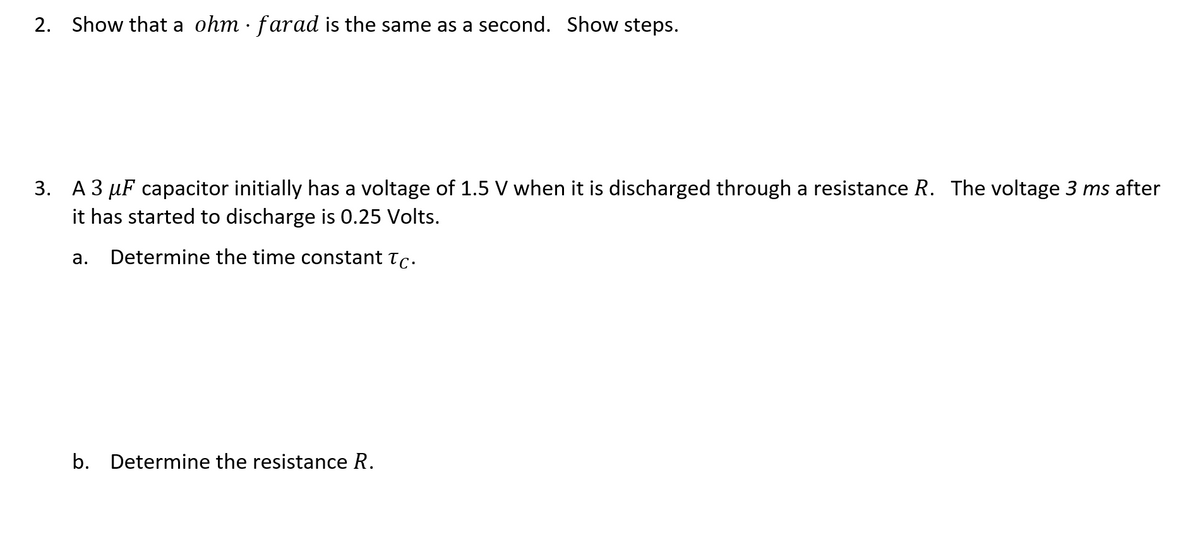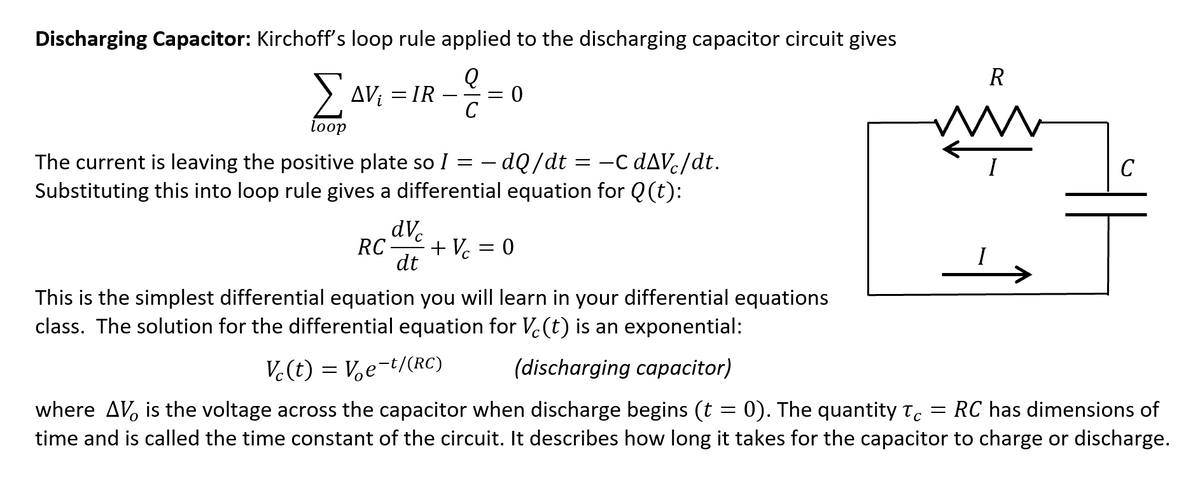2. Show that a ohm · farad is the same as a second. Show steps. 3. A 3 µF capacitor initially has a voltage of 1.5 V when it is discharged through a resistance R. The voltage 3 ms after it has started to discharge is 0.25 Volts. a. Determine the time constant tc. b. Determine the resistance R.
2. Show that a ohm · farad is the same as a second. Show steps. 3. A 3 µF capacitor initially has a voltage of 1.5 V when it is discharged through a resistance R. The voltage 3 ms after it has started to discharge is 0.25 Volts. a. Determine the time constant tc. b. Determine the resistance R.
Introductory Circuit Analysis (13th Edition)
13th Edition
ISBN:9780133923605
Author:Robert L. Boylestad
Publisher:Robert L. Boylestad
Chapter1: Introduction
Section: Chapter Questions
Problem 1P: Visit your local library (at school or home) and describe the extent to which it provides literature...
Related questions
Question
100%

Transcribed Image Text:2. Show that a ohm · farad is the same as a second. Show steps.
3. A 3 µF capacitor initially has a voltage of 1.5 V when it is discharged through a resistance R. The voltage 3 ms after
it has started to discharge is 0.25 Volts.
а.
Determine the time constant Tc.
b. Determine the resistance R.

Transcribed Image Text:Discharging Capacitor: Kirchoff's loop rule applied to the discharging capacitor circuit gives
R
> AV: = IR –
Δν
C
loop
The current is leaving the positive plate so I = – dQ/dt = -C DAV-//dt.
-c dAVc/dt.
C
Substituting this into loop rule gives a differential equation for Q (t):
dVe
RC
+ V = 0
dt
This is the simplest differential equation you will learn in your differential equations
class. The solution for the differential equation for V.(t) is an exponential:
V.(t) = Ve-t/(RC)
(discharging capacitor)
where AV, is the voltage across the capacitor when discharge begins (t = 0). The quantity t.
time and is called the time constant of the circuit. It describes how long it takes for the capacitor to charge or discharge.
RC has dimensions of
Expert Solution
This question has been solved!
Explore an expertly crafted, step-by-step solution for a thorough understanding of key concepts.
This is a popular solution!
Trending now
This is a popular solution!
Step by step
Solved in 2 steps with 2 images

Knowledge Booster
Learn more about
Need a deep-dive on the concept behind this application? Look no further. Learn more about this topic, electrical-engineering and related others by exploring similar questions and additional content below.Recommended textbooks for you

Introductory Circuit Analysis (13th Edition)
Electrical Engineering
ISBN:
9780133923605
Author:
Robert L. Boylestad
Publisher:
PEARSON

Delmar's Standard Textbook Of Electricity
Electrical Engineering
ISBN:
9781337900348
Author:
Stephen L. Herman
Publisher:
Cengage Learning

Programmable Logic Controllers
Electrical Engineering
ISBN:
9780073373843
Author:
Frank D. Petruzella
Publisher:
McGraw-Hill Education

Introductory Circuit Analysis (13th Edition)
Electrical Engineering
ISBN:
9780133923605
Author:
Robert L. Boylestad
Publisher:
PEARSON

Delmar's Standard Textbook Of Electricity
Electrical Engineering
ISBN:
9781337900348
Author:
Stephen L. Herman
Publisher:
Cengage Learning

Programmable Logic Controllers
Electrical Engineering
ISBN:
9780073373843
Author:
Frank D. Petruzella
Publisher:
McGraw-Hill Education

Fundamentals of Electric Circuits
Electrical Engineering
ISBN:
9780078028229
Author:
Charles K Alexander, Matthew Sadiku
Publisher:
McGraw-Hill Education

Electric Circuits. (11th Edition)
Electrical Engineering
ISBN:
9780134746968
Author:
James W. Nilsson, Susan Riedel
Publisher:
PEARSON

Engineering Electromagnetics
Electrical Engineering
ISBN:
9780078028151
Author:
Hayt, William H. (william Hart), Jr, BUCK, John A.
Publisher:
Mcgraw-hill Education,